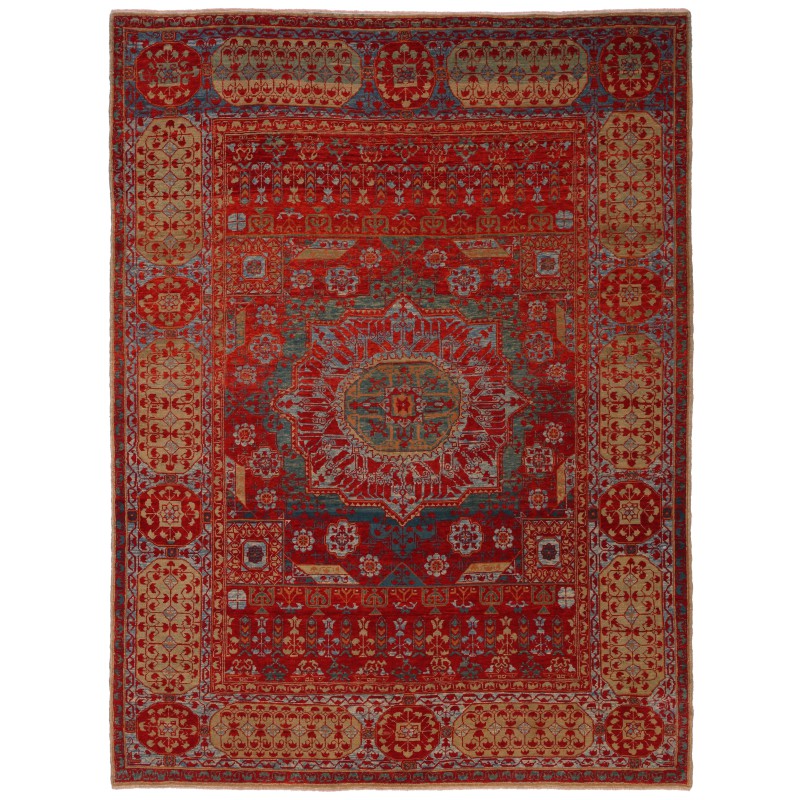
- Stock: 売り切れ
- Model: C50056
- サイズ: 222cm x 169cm
- SKU: ART56
この絨毯の情報源は、Esin Atilによる書籍「Renaissance of Islam, Art of the Mamluks」、スミソニアン協会出版、ワシントンD.C.、1981年、番号127です。この中央に星のある絨毯は、エジプトのカイロのマムルークスルタンによって16世紀初頭にデザインされました。ワシントンD.C.にあるテキスタイル博物館で展示されています(R.16.2.3)。この例では、初期のマムルーク絨毯に見られる鮮やかな赤、緑、青に加えて、茶色や黄色など他の色も追加されています。この絨毯のレイアウトは、8の倍数に基づいた幾何学的なパターンを含んでいます。他の絨毯でより目立つ八角形は、周囲の三角形と混ざり合って16本の尖った星になりました。中央の正方形と横断バンドは赤い地になっており、上部と下部の部分はモチーフや表面の色の変化のみで区別されます。中央の正方形の主題は、青い地に赤いランセットの葉がある16本の尖った星です。中央の黄色のメダリオンには赤と緑の花が詰まっており、その周りには8本の尖った星があります。この星は、その中心に多重花弁の薔薇の花があり、その周りには四角形の中にダイヤモンドが囲まれています。16本の尖った星は、各葉っぱの間に挿入された8つの葉っぱを持つ緑のバンドに囲まれています。葉っぱの間に散りばめられた16個の多角形が、フレームによって先端が切り取られたもう1つの16本の尖った星を作り出します。角には、蓮の花で満たされた格子状の八角形を囲む四角形の単位があり、組成を完成させています。中央の正方形の上下にある長方形のバンドには、中心に向かって配向された3つの水平な花単位の行があります。内側の行には花単位と交互に、中央の小型のシプレスと大きなパピルスの噴出物が交互に配置されており、外側の行には2種類のアラベスクのカルトゥーシュがあります。青いボーダーは緑の楕円形と赤いメダリオンで満たされており、同じ緑または赤のパピルスの噴出物と青い菱形が含まれています。赤いパピルスの噴出物の間には追加の赤いパピルスの噴出物が埋まっています。単位は、各メダリオンの四辺に配置された小さな丸い装飾パーツに取り囲まれた連続した黄色のリボンで囲まれています。二重のガードボーダーには、赤い地に描かれた2種類の花の巻きスクロールがあります。中心から放射状に広がる中心から外部の要素がフレームによって切り取られた全体的な効果は、写本の装飾と類似しており、非常に印象的です。カルトゥーシュとメダリオンをつなぐ細いリボンは、同時代の写本や15世紀後半のオブジェでも見られます。横断バンドに使用されている特異な花瓶のような植物やアラベスクのカルトゥーシュは、いくつかのマムルーク絨毯に見られ、マムルーク織り手のレパートリーの一部であるようです。絨毯のデザインは私たちのデザイナーによって解釈され、オリジナルに合わせた最適な色がこの絨毯に使用されています。
The source of the rug comes from the book Renaissance of Islam, Art of the Mamluks, Esin Atil, Smithsonian Institution Press, Washington D.C., 1981 nr.127. This rug with the central star was designed in the early 16th-century rug by Mamluk Sultane of Cairo, Egypt. It is exhibited at the Washington D.C. The Textile Museum, R.16.2.3 . The brilliant reds, greens, and blues found on the earlier Mamluk rugs were later enhanced by the addition of other colors, such as brown and yellow, as seen in this example. The layout of this rug contains a geometric pattern based on multiples of eight. The octagon, which is more prominent in the other rugs, has blended with the encircling triangles to become a sixteen. pointed star. The central square and transverse. bands share red ground, the upper and lower portions distinguishable only by the variation in motifs and surface colors. The main theme of the central square is a sixteen-pointed star with red lancet leaves on blue ground. The yellow medallion in the middle is filled with red and green flowers, which form a double quatrefoil around an eight-pointed star; this star encloses an identical element, in the core of which is a multipetaled rosette surrounded by a diamond in a square. The sixteen-pointed star is encircled by a green band that has eight arms with lobed medallions inserted between them. Sixteen polygons interspersed around the lobed medallions create another sixteen-pointed star, its points cut off by the frame. Square units in the corners, enclosing octagons surrounded by a lattice filled with lotus blossoms, complete the composition. The rectangular bands above and below the central square have three horizontal rows of floral units oriented toward the center. The inner row contains chalicelike plants interspersed with floral units; the middle alternates stylized miniature cypresses with larger papyrus sprays surmounted by lotuses, and the outer row has two types of arabesque cartouches. The blue border is filled with green ovals and red medallions containing the same green or red papyrus sprays and blue lozenges. Additional sprays of red papyrus fill the interstices. The units are framed by a continuous yellow ribbon that loops around the tiny roundels placed on four sides of each medallion. The double guard borders have two types of floral scrolls, rendered in red on blue and green on red. The overall effect of a centrifugal design radiating from the core, its outermost elements cut off by the frame, is strikingly similar to the compositions of manuscript illuminations. The thin ribbon connecting the cartouches and medallions is also seen in contemporary illumination and late-fifteenth-century objects. The peculiar chalicelike plants and the arabesque cartouches used in the transverse bands are found on several Mamluk rugs and appear to be a part of the repertoire of Mamluk weavers. The design of the rug is interpreted by our designers, and the most appropriate colors to match the original is used for this rug.
- Imperial Red 426 (茜)
- Emerald Green 407 (カモミール - 藍)
- Cadet Blue 26 (トウダイグサ - 藍)
- Emerald Green 407 (カモミール - 藍)
上の番号は私たちのカラーコードです。()の中は、主な草木染めの材料です。
